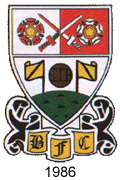Barnet
The early history of Barnet is both complex and confusing and recent research has cast doubt on the official version. Records show that in 1882 former pupils of Cowley College formed Woodville FC. At the beginning of the 1885-86 season they merged with Lyonsdown FC and became New Barnet FC. Players who failed to turn out in the official colours black shirts, stockings and caps with white knickerbockers faced a fine of 6d (2.5p). After moving to a new ground in 1888, the club adopted the title of Barnet FC. Playing in black and violet, this club competed in the amateur Olympian League and later the North London League. In 1901 the club was suspended for six weeks for breaching the strict rules on payments to amateur players. This precipitated a financial crisis and in November 1901, the original Barnet FC was wound up.
Research by local historians Tony Rainer and Steve Wilmott suggests that the modern club is in fact descended from two quite separate sides who existed alongside, and indeed played against the original Barnet. The first of these was formed in 1890 by former pupils of Christ Church School and was known as Avenue FC and then Barnet Avenue FC. They competed in the North Middlesex League alongside Barnet FC. In 1903 two years after the original Barnet went out of existence, the Avenue club became themselves known as Barnet. In 1905 they joined the London League Second Division. Meanwhile, in 1901 the general manager of the Dental Manufacturing Company Ltd formed a football and athletic club for his staff, Alston Works Athletic FC. In July 1904 they became a senior side and changed their name to Barnet Alston. Playing in old gold and black, they were elected to the London League in 1906. In 1912 the two clubs merged to form Barnet & Alston FC and became founder members of the Athenian League. For a single season they played in the violet and black of the original club before adopting the black and amber colours of the former Alston team. When the club was reformed at the end of the First World War, they became simply Barnet FC.
The Bees (so called because of their amber and black strip) continued to play in the amateur Athenian League until they finally adopted professionalism in 1965 and joined the Southern League. Altogether they won the Athenian League championship seven times and the FA Amateur Cup once, in 1946.
The club's crest was designed in the 1950s and contains the green hill of High Barnet. The red and white roses with crossed swords represent the 1471 Battle of Barnet, a pivotal incident in the Wars of the Roses. The badge was designed by Sidney Robert Price who was the chairman of the club at the time. This appeared on players' shirts for the first time in 1986.
The late 1970s saw two of the games most colourful characters associated with Barnet. Jimmy Greaves ended his playing career with two seasons at the club and Barry Fry became manager in 1978. In 1984, with the club on the brink of closure, Fry moved to Maidstone United and a new chairman, Stan Flashman bailed the club out. Two years later, Fry was back. When it was announced that the Gola League in which Barnet competed would become the Conference with a place in the Football League as its prize, Fry and Flashman set out their ambition to take the club into the top flight.
After a string of disappointing near misses, Barnet achieved promotion to Division Four in 1991 and capped this with promotion to the (new) Division Two in 1993. The new level proved too much and the following season Barnet were back in Division Three where they stayed until 2001 when they were relegated back to the Conference. In 2005 the club won the Conference championship and returned to League football.
To mark 100 years at Underhill in 2007, Barnet unveiled an old gold and black kit, based on that of Barnet Alston.
For the opening matches of the 2010-11 season, the team wore unsponsored shirts from the previous season until a sponsorship draw was belatedly organised.
